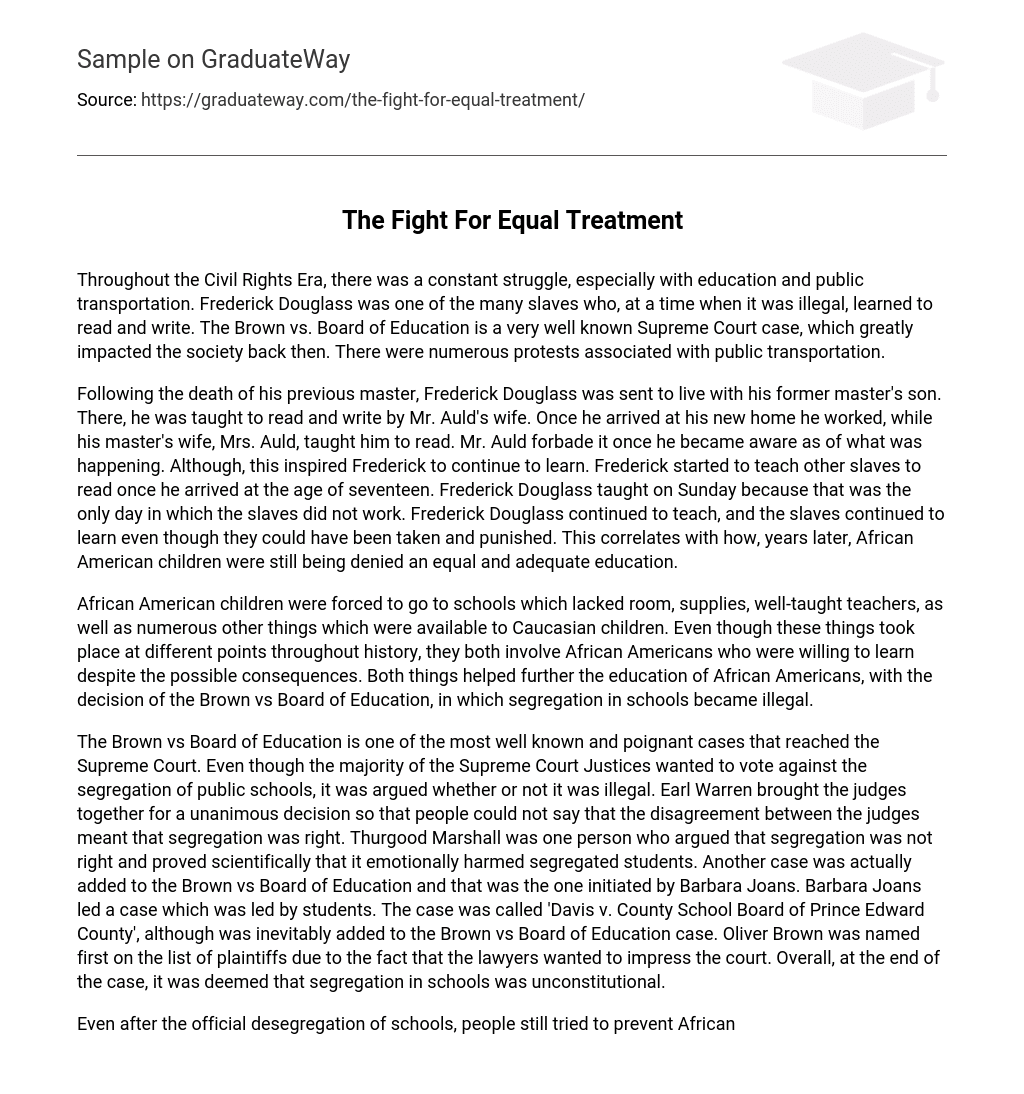Throughout the Civil Rights Era, there was a constant struggle, especially with education and public transportation. Frederick Douglass was one of the many slaves who, at a time when it was illegal, learned to read and write. The Brown vs. Board of Education is a very well known Supreme Court case, which greatly impacted the society back then. There were numerous protests associated with public transportation.
Following the death of his previous master, Frederick Douglass was sent to live with his former master’s son. There, he was taught to read and write by Mr. Auld’s wife. Once he arrived at his new home he worked, while his master’s wife, Mrs. Auld, taught him to read. Mr. Auld forbade it once he became aware as of what was happening. Although, this inspired Frederick to continue to learn. Frederick started to teach other slaves to read once he arrived at the age of seventeen. Frederick Douglass taught on Sunday because that was the only day in which the slaves did not work. Frederick Douglass continued to teach, and the slaves continued to learn even though they could have been taken and punished. This correlates with how, years later, African American children were still being denied an equal and adequate education.
African American children were forced to go to schools which lacked room, supplies, well-taught teachers, as well as numerous other things which were available to Caucasian children. Even though these things took place at different points throughout history, they both involve African Americans who were willing to learn despite the possible consequences. Both things helped further the education of African Americans, with the decision of the Brown vs Board of Education, in which segregation in schools became illegal.
The Brown vs Board of Education is one of the most well known and poignant cases that reached the Supreme Court. Even though the majority of the Supreme Court Justices wanted to vote against the segregation of public schools, it was argued whether or not it was illegal. Earl Warren brought the judges together for a unanimous decision so that people could not say that the disagreement between the judges meant that segregation was right. Thurgood Marshall was one person who argued that segregation was not right and proved scientifically that it emotionally harmed segregated students. Another case was actually added to the Brown vs Board of Education and that was the one initiated by Barbara Joans. Barbara Joans led a case which was led by students. The case was called ‘Davis v. County School Board of Prince Edward County’, although was inevitably added to the Brown vs Board of Education case. Oliver Brown was named first on the list of plaintiffs due to the fact that the lawyers wanted to impress the court. Overall, at the end of the case, it was deemed that segregation in schools was unconstitutional.
Even after the official desegregation of schools, people still tried to prevent African American children from being able to go to the schools. For instance, in Little Rock Arkansas, Orval Fabus used the National Guard to stop the children from being able to enter the school, as well as numerous protestors. Once Dwight Eisenhower found out, he sent the 101st Airborne to escort these children to the school.
Public Transportation was a large part throughout the Civil Rights Era, there were numerous protests as well as boycotts. One example is the Montgomery Bus Boycott, where Rosa Parks refused to give up her seat to a Caucasian male and was thus removed from the bus. To protest, African Americans would sit at the bus station in droves, pay their fare, before not getting off. The African American protestors worked in shifts getting on and off of the bus, not allowing anyone else on the bus. This largely cut into the bus company’s profits as much as ninety percent. This protest ultimately led to the formation of the Southern Christian Leadership Conference forming in 1957, with Martain Luther King Jr. as one of the founding members. Another famous protest of public transportation was the Freedom Riders when they headed to Louisiana in 1961. The Freedom Riders rode from Washington D.C. to Louisiana in a large bus filled with both African American and Caucasian protestors. The Freedom Riders encountered a lot of resistance, with their bus even being burned down.
Overall, education and public transportation were large parts of the Civil Rights Era, as well as providing significant changes to society. From single people like Rosa Parks and Frederick Douglass to the many people who participated in the Montgomery Bus Boycott and Freedom Riders, education and the desegregation of public transportation has always been a large part of the fight for equal treatment since before the Civil War.





